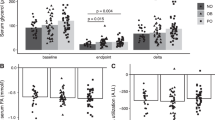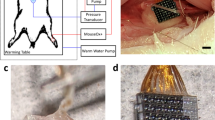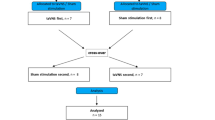Abstract
OBJECTIVE: To investigate the possible role of peripheral sympathetic activity in gastric bypass-induced body weight loss.
SUBJECTS AND METHODS: In 42 morbidly obese patients (sex: 36 f/6 m; BMI: 46.0±0.7 kg/m2) undergoing a gastric bypass, the skin vasoconstrictor reflex in answer to a deep inspiration was measured by laser Doppler fluximetry. The extent of vasoconstriction, measured at the second finger of the left hand, was expressed as percent reduction of the basal blood flux (% vasoconstriction). Insulin sensitivity was assessed before surgery in a subset of patients (n=11), by the method of euglycemic, hyperinsulinemic clamp. Body weight and composition were evaluated before, and 3, 6 and 12 months after surgery. At the same time points, energy intake (kJ/day) was evaluated by means of both food record diary and alimentary anamnesis.
RESULTS: The % vasoconstriction, which was significantly (P=0.01) greater in normoglycemic subjects than in diabetic ones, was also significantly (P=0.03) related to the extent of insulin sensitivity measured during the euglycemic clamp.
The % vasoconstriction showed a significant (P>0.0001), positive correlation with weight reduction obtained between the 6th and 12th months following surgery; as a consequence, % vasoconstriction was significantly (P=0.0004) related to the overall body weight loss achieved during the year following the operation. These correlations remained significant in multiple regression analysis with adjustment for age, initial body weight, plasma glucose and insulin (P=0.0007 and 0.006, respectively). The % vasoconstriction was also significantly (P=0.0006), negatively related to energy intake measured 12 months after surgery.
CONCLUSIONS: In conditions of stable body weight, the sympathetic nervous system (SNS) reactivity is influenced by the degree of insulin resistance. A high capacity to activate the SNS, measured before surgery, is associated with both a larger gastric bypass-induced weight loss and a lower energy intake, at the phase of weight stabilization.
This is a preview of subscription content, access via your institution
Access options
Subscribe to this journal
Receive 12 print issues and online access
$259.00 per year
only $21.58 per issue
Buy this article
- Purchase on Springer Link
- Instant access to full article PDF
Prices may be subject to local taxes which are calculated during checkout




Similar content being viewed by others
References
Snitker S, MacDonald I, Ravussin E, Astrup A . The sympathetic nervous system and obesity: role in aethiology and treatment. Obes Rev 2000; 1: 5–16.
Van Baak MA . The peripheral nervous system in obesity. Obes Rev 2001; 2: 3–14.
O'Dea K, Esler M, Leonard P, Stockigt JR, Nestel P . Noradrenaline turnover during under- and over-eating in normal weight subjects. Metabolism 1982; 31: 896–899.
Rosenbaum M, Hirsch J, Murphy E, Liebel R . Effects of changes in body weight on carbohydrate metabolism, catecholamine excretion, and thyroid function. Am J Clin Nutr 2000; 71: 1421–1432.
Spraul M, Ravussin E, Fontvieille AM, Rising R, Larson DE, Anderson EA . Reduced sympathetic activity. A potential mechanism predisposing to body weight gain. J Clin Invest 1993; 92: 1730–1735.
Bazelmans J, Nestel PJ, O'Dea L, Esler M . Blunted norepinephrine responsiveness to changed energy states in obese subjects. Metabolism 1985; 34: 154–160.
Andersson B, Elam M, Wallin G, Bjontorp P, Andersson OK . Effect of energy-restricted diet on sympathetic muscle nerve activity in obese women. Hypertension 1991; 18: 783–789.
Hellström L, Reynisdottir S, Langin D, Rössner S, Arner P . Regulation of lipolysis in fat cells of obese women during long-term hypocaloric diet. Int J Obes Relat Metab Disord 1996; 20: 745–752.
Flechtner-Mors M, Ditschuneit HH, Yip I, Adler G . Sympathetic modulation of lipolysis in subcutaneous adipose tissue: effects of gender and energy restriction. J Lab Clin Med 1999; 134: 33–41.
Bougnères P, Le Stunff C, Pecqueur C, Pinglier E, Adnot P, Ricquier D . In vivo resistance of lipolysis to epinephrine. J Clin Invest 1997; 99: 2568–2573.
Hellström L, Rössner S, Hagström-Toft E, Reynisdottir S . Lipolytic catecholamine resistance linked to alpha-2 adrenoreceptor sensitivity: a metabolic predictor of weight loss in obese subjects. Int J Obes Relat Metab Disord 1997; 21: 314–320.
Also Y, Inukai T, Takemura Y . Evaluation of skin vasomotor reflexes in response to deep inspiration in diabetic patients by Laser Doppler flowmetry. Diabetes Care 1997; 20: 1324–1328.
Muscelli E, Emdin M, Natali A, Pratali L, Camastra S, Gastaldelli A, Baldi S, Carpeggiani C, Ferrannini E . Autonomic and hemodynamic response to insulin in lean and obese humans. J Clin Endocrinol Metab 1998; 83: 2084–2090.
Sugerman HJ, Kellum JM, Engle KM, Wolfe L, Starkey JV, Birkenhauer R, Fletcher P, Sawyer MJ . Gastric bypass for treating severe obesity. Am J Clin Nutr 1992; 55: 560S–566S.
Caraway WT . Carbohydrates. In: Tietz NW (ed). Fundamental of clinical chemistry, 2nd edn. WB Saunders CO: Philadelphia, 1987, p 427.
Hebert V, Gottlieb CW, Bleicher SY . Coated charcoal immunoassay of insulin. J Clin Endocrinol Metab 1965; 25: 1175–1184.
DeFronzo RA, Tobin JD, Andres R . Glucose clamp technique: a method for quantifying insulin secretion and resistance. Am J Physiol 1979; 237: E214–E223.
Segal KR, Van Loan M, Fitzgerald PI, Hodgdon JA, Van Itallie TB . Lean body mass estimation by bioelectrical impedance analysis: a four-site cross-validation study. Am J Clin Nutr 1988; 47: 7–14.
The Expert Committee on the diagnosis classification of diabetes mellitus. Report of the expert committee on the diagnosis and the classification of diabetes mellitus. Diabetes Care 1997; 20: 1183–1197.
Serne EH, Stehouwer CD, Maaten JC, Ter Wee PM, Rauwerda JA, Gans RO . Microvascular function relates to insulin sensitivity and blood pressure in normal subjects. Circulation 1999; 99: 896–902.
Vollenwilder P, Randin D, Tappy L, Jéquier E, Nicod P, Scerrer U . Impaired insulin-induced sympathetic neural activation and vasodilation in skeletal muscle in obese humans. J Clin Invest 1994; 936: 2365–2371.
Spraul M, Anderson EA, Bogardus C, Ravussin E . Muscle sympathetic nerve activity in response to glucose ingestion. Impact of plasma insulin and body fat. Diabetes 1994; 43: 191–196.
Grassi G, Serravalle G, Cattaneo BM, Bolla GB, Lanfranchi A, Colombo M, Giannattasio C, Brunani A, Cavagnini F, Mancia G . Sympathetic activation in obese normotensive subjects. Hypertension 1995; 25: 560–563.
Astrup A, Buemann B, Gluud C, Bennet P, Tjur T, Christensen N . Prognostic markers for diet-induced weight loss in obese women. Int J Obes Relat Metab Disord 1995; 9: 275–278.
Patel JN, Coppack SW, Goldstein DS, Miles JM, Eisenhofer G . Norepinephrine spillover form human adipose tissue before and after a 72-hour fast. J Clin Endocrinol Metab 2002; 87: 3373–3377.
Leibel RL, Rosenbaum M, Hirsch J . Changes in energy expenditure resulting from altered body weight. N Engl J Med 1995; 332: 621–628.
Bobbioni-Harsch E, Morel P, Huber O, Assimacopoulos-Jeannet F, Chassot G, Lehmann T, Volery M, Golay A . Energy economy hampers body weight loss after gastric bypass. J Clin Endocrinol Metab 2000; 85: 4695–4700.
Patel JN, Eisenhofer G, Coppack SW, Miles J . Norepinephrine spillover in forearm and subcutaneous adipose tissue before and after eating. J Clin Endocrinol Metab 1999; 84: 2815–2819.
Tsujii S, Bray G . A beta-3 adrenergic agonist (BRL-37.344) decreases food intake. Physiol Behav 1998; 63: 723–728.
Näslund I, Jämmark I, Andersson H . Dietary intake before and after gastric bypass and gastroplasty for morbid obesity. Int J Obes Relat Metab Disord 1988; 12: 503–513.
Bobbioni-Harsch E, Huber O, Morel P, Chassot G, Lehmann T, Volery M, Chliamovitch E, Muggler C, Golay A . Factors influencing energy intake and body weight loss after gastric bypass. Eur J Clin Nutr 2002; 56: 551–556.
Acknowledgements
This study was supported by the Swiss National Funds for Scientific Research, Grant nos. 32-61339.00 and 32-45893.95/1. We thank Ms Nuria Flores and Ms Francine Califano for their skillfull secretarial and technical assistance.
Author information
Authors and Affiliations
Corresponding author
Rights and permissions
About this article
Cite this article
Bobbioni-Harsch, E., Bongard, O., Habicht, F. et al. Relationship between sympathetic reactivity and body weight loss in morbidly obese subjects. Int J Obes 28, 906–911 (2004). https://doi.org/10.1038/sj.ijo.0802620
Received:
Revised:
Accepted:
Published:
Issue Date:
DOI: https://doi.org/10.1038/sj.ijo.0802620
Keywords
This article is cited by
-
Effects of Whole-Body Electromyostimulation Associated with Dynamic Exercise on Functional Capacity and Heart Rate Variability After Bariatric Surgery: a Randomized, Double-Blind, and Sham-Controlled Trial
Obesity Surgery (2020)
-
Impact of Aerobic Exercise Training on Heart Rate Variability and Functional Capacity in Obese Women After Gastric Bypass Surgery
Obesity Surgery (2011)
-
Les 10es Entretiens de nutrition, institut Pasteur de Lille L’obésité, une maladie nutritionnelle ?
Obésité (2008)
-
The effect of insulin on cardiac autonomic balance predicts weight reduction after gastric bypass
Diabetologia (2005)



